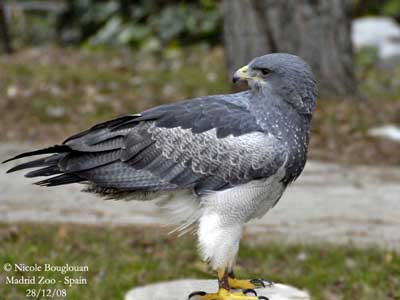
Fr: Buse aguia
All : Agula
Esp: Águila Mora
Ital: Poiana-aquila pettonero
Nd: Grijze Arendbuizerd
Sd: Svartbröstad vråkörn
Port: Águia-chilena
Photographers:
Eduardo Andrés Jordan
MIS AVES – AVES DE ARGENTINA
Nicole Bouglouan (Captive birds)
PHOTOGRAPHIC RAMBLE
Text by Nicole Bouglouan
Sources:
HANDBOOK OF THE BIRDS OF THE WORLD Vol 2 by Josep del Hoyo-Andrew Elliot-Jordi Sargatal - Lynx Edicions - ISBN: 8487334156
A GUIDE TO THE BIRDS OF COLOMBIA by Steven L. Hilty and William L. Brown - Princeton University Press – ISBN 069108372X
Avibase (Lepage Denis)
BirdLife International (BirdLife International)
SORA Searchable Ornithological Research Archive (Blair O. Wolf)
Wikipedia, the free encyclopaedia
Black-chested Buzzard-Eagle
Geranoaetus melanoleucus
Accipitriforme Order – Accipitridae Family
BIOMETRICS:
Length: 62-80 cm
Wingspan: 175-200 cm
Weight: 1700-3200 g
DESCRIPTION:
The Black-chested Buzzard-Eagle is a large South American raptor often seen soaring in thermals currents while looking for preys.
This eagle has long and broad wings and short, wedge-shaped tail.

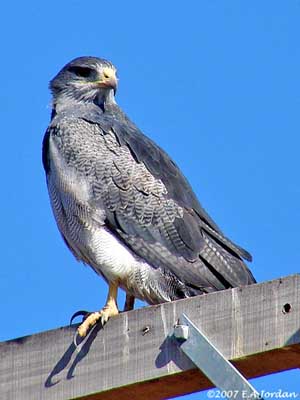
The adult male has bluish to slate-black or even deep sooty brown upperparts. The shoulders are ashy grey finely barred black. The tail is black with narrow greyish-white terminal band.
On the underparts, the breast is black or dark grey, whereas the remaining underparts are white and finely barred blackish, but this pattern is often indistinct.
The head is slate-black with whitish chin and throat. The hooked bill is greyish-black with yellow cere. The eyes are dark brown. Legs and feet are yellow.
The female has similar plumage but she is much larger than the male.
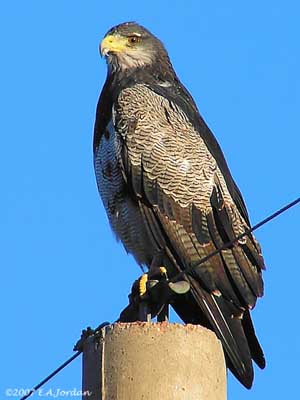
The immature is deep brown to blackish, and lacks the grey shoulders of the adults. The underparts are white or buff, and the breast is heavily streaked black, whereas belly and thighs are barred. It needs several years to gain the adult plumage.
We can find two subspecies:
G.m. melanoleucus is found in S and E Brazil to Paraguay, E Argentina and Uruguay.
G.m. australis is found in NW Venezuela through W South America S to Tierra del Fuego.
This one is smaller than nominate, and always shows some barring on the white underparts.
VOICE: SOUNDS BY XENO-CANTO
The Black-chested Buzzard-Eagle gives high reedy whistles close to the nest and often when flying. The sounds can vary from a wild human laugh to a clear note.
HABITAT:
The Black-chested Buzzard-Eagle occurs mainly in mountains in the northern parts of the range, between 1600 and 3500 metres of elevation in Colombia, but also up to 4600 metres according to the location.
It can be common on steppes, grassy foothills and rocky uplands, and also frequents valleys, Nothofagus woodland, dunes and desert regions.
RANGE:
See above in “subspecies”.
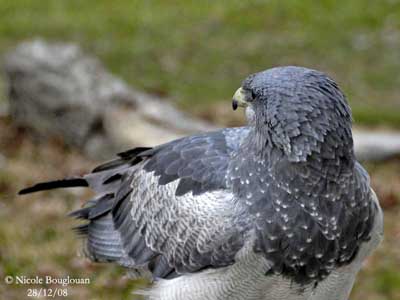
BEHAVIOUR:
The Black-chested Buzzard-Eagle feeds primarily on small mammals, some birds, snakes and lizards, seasonally insects and also carrion.
It is able to catch large preys such as guans, foxes and skunks.
It hunts in mid-morning and afternoon, and spends most time soaring in pairs on thermal currents and updraughts along slopes and ridgetops. It perches on rocks, ledges or on the ground, rarely in trees.
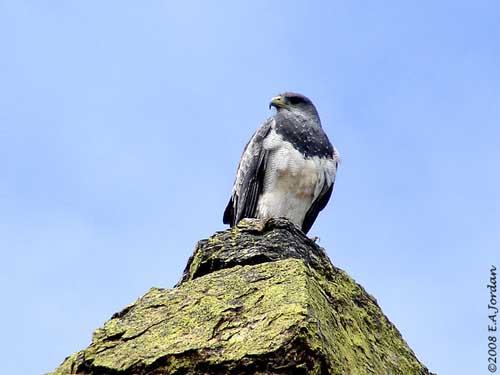
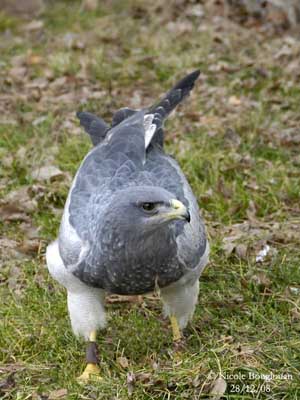
The Black-chested Buzzard-Eagle can be aggressive if threatened, and especially at nest. It attacks strongly all intruders, including humans.
During the breeding season, they perform aerial displays in the surroundings of the nest-site. Copulations occur over at least two weeks.
This raptor is probably sedentary in its range.
FLIGHT:
The Black-chested Buzzard-Eagle is often seen soaring in thermal currents, and frequently in pairs. They are graceful but heavy with bulky body and wings held flat. The short tail helps to identify this raptor.
REPRODUCTION:
The breeding season varies according to the range.
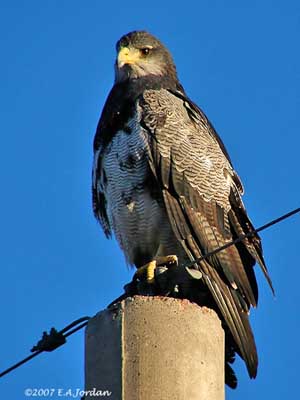
The Black-chested Buzzard-Eagle nests often very high in cliffs when living in mountainous regions. But in lower areas, the nest is placed at top of tall tree or cacti when trees are lacking, sometimes on bushes and rarely on the ground.
The nest is made with sticks and can be reused, but they often build a new one.
The female lays 1-3 eggs, usually two. The incubation lasts about one month.
Both parents feed the chicks and defend the nest. They attack and chase away from the nest-site all intruders flying by.
DIET:
The Black-chested Buzzard-Eagle feeds mainly on small mammals such as rodents (Octodon degus) and rabbits. It also takes some birds such as Burrowing Owls and larger preys such as Chilean Tinamous, guans, grey foxes and skunks (Conepatus). It can also take snakes and lizards, insects and carrion.
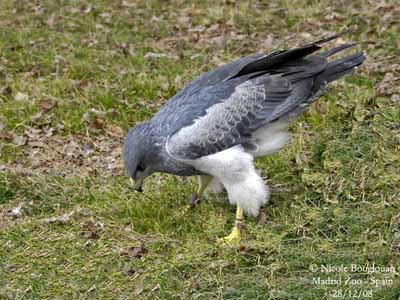
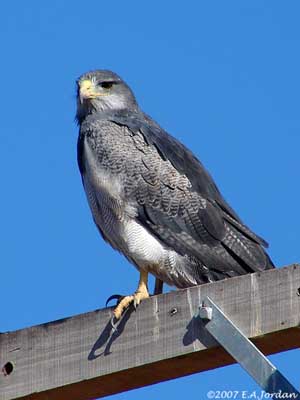
PROTECTION/THREATS/STATUS:
The Black-chested Buzzard-Eagle is usually fairly common in its range.
Some declines are reported in S Argentina, due to poisoning used by ranchers.
But this species is not currently threatened.